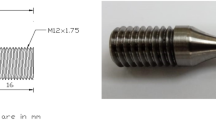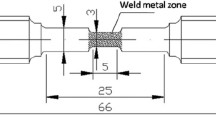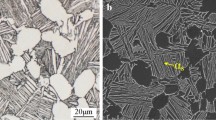Abstract
Development of burn-resistant titanium alloys is the most direct way of mitigating the ignition and propagation of titanium fires in jet engines. WSTi3515S alloy (Ti–35V–15Cr–0.3Si–0.1C) is a new high alloying beta type burn-resistant titanium alloy, belonging to Ti–V–Cr type alloys which have been made significant progress in engineering technology in the past 5 years. The physical properties of WSTi3515S burn-resistant titanium alloy such as the elastic properties and thermal properties were measured and analyzed in different conditions. The results show that both the Young’s modulus and shear modulus of WSTi3515S alloy decrease slightly with the temperature increasing at the tested temperature range. The Poisson’s ratio of WSTi3515S alloy is around 0.36. However, the thermal properties such as the specific heat, thermal diffusivity, thermal conductivity and thermal expansion increase with the temperature increasing, which results from the strengthening of lattice heat vibration at elevated temperature. And the room temperature density of WSTi3515S alloy is 5.295 g·cm−3.






Similar content being viewed by others
References
Zhao YQ, Zhao XM, Zhu KY, Luo GZ, Zhou L. Burn resistant titanium alloy. Rare Met Mater Eng. 1996;25(5):1.
Lai YJ, Zhang PX, Xin SW, Ma FJ, Liu XH, Feng Y, Zeng WD, Li JS. Progress on engineered technology of burn-resistant titanium alloys in China. Rare Met Mater Eng. 2015;44(8):2067.
Zhao YQ, Zhou L, Deng J. The role of interface in the burning of titanium alloys. Mater Sci Eng A. 1999;267(6):167.
Sun Y, Zeng WD, Zhao YQ, Zhang XM, Shu Y, Zhou YG. Modeling constitutive relationship of Ti40 alloy using artificial neural network. Mater Des. 2011;32(20):1537.
Soo SL, Hood R, Lannette M, Aspinwall DK, Wayne E. Voice. Creep feed grinding of burn-resistant titanium (BuRTi) using superabrasive wheels. Int J Adv Manuf Technol. 2011;53(8):1019.
Lai YJ, Lei Q, Ma FJ, Du JC, Zheng YJ, Zhang W, Zhang FS, Cao JX, Huang X, Liu XH, Feng Y, Zhang PX. A melting method of high alloyed beta type titanium alloy. China Patent; 10014795.8. 2011.
Cao JX, Huang X, Mi GB, Sha AX, Wang B. Research progress on application technique of Ti–V–Cr burn resistant titanium alloys. J Aeronaut Mater. 2014;34(4):92.
Lai YJ, Zhang PX, Xin SW, Ma FJ, Feng Y, Liu XH, Kou HC, Zhao YQ. Effect of heat treatment on microstructure and mechanical properties of WSTi3515S alloy. Rare Met Mater Eng. 2015;44(6):1469.
Hansen JO, Novotnak D, Welter MF, Wood JR. Properties and processing of a high strength beta titanium alloy. In: Proceedings of the 8th World Conference on Titanium. London; 1996. 675.
Sun Y, Zeng WD, Zhao YQ, Zhang XM, Shu Y, Zhou YG. Research on the hot deformation behavior of Ti40 alloy using processing map. Mater Sci Eng A. 2011;528(3):1205.
Ward CH, Spanos G, Broderick TF, Reshad R. Isothermal transformation of precipitates in Alloy C+. In: Proceedings of the 8th World Conference on Titanium. London; 1996. 2377.
Broderick TF, Reshad J, Ward CH, Scheltens FJ. Solvus temperatures of various phases in alloy C+. In: Proceedings of the 8th World Conference on Titanium. London; 1996. 2385.
Xin SW, Zhao YQ, Zeng WD, Wu H. Analysis and discussion of mechanical properties and microstructure developments for Ti40 alloy thermal exposed at 550 C. Rare Met Mater Eng. 2008;37(3):423.
Xin SW, Zhao YQ, Lu YF, Li Q, Yang HY. Role of grain boundaries in the high-temperature performance of a highly stabilized beta titanium alloy I: thermal stability. Mater Sci Eng A. 2013;559(10):1.
Xin SW, Zhao YQ, Lu YF, Li Q, Yang HY. Role of grain boundaries in the high-temperature performance of a highly stabilized beta titanium alloy II: creep behavior. Mater Sci Eng A. 2013;559(10):7.
Wan MP, Zhao YQ, Zeng WD. Phase transformation kinetics of Ti-1300 alloy during continuous heating. Rare Met. 2015;34(4):233.
Chen HS. State-of-art of physical property testing techniques for metallic materials. Rare Met Mater Eng. 1991;20(4):15.
Jones W, March NH. Theoretical Solid State Physics. New York: Courier Dover Publications; 1985. 22.
Bykov VA, Kulikova TV, Vedmid LB, Fishman AY, Shunyaev KY, Tarenkova NY. Thermophysical properties of Ti–5Al–5V–5Mo–3Cr–1Zr titanium alloy. Phys Met Metallogr. 2014;115(7):705.
Acknowledgments
This study was financially supported by the International Science and Technology Cooperation Program of China (No. ISTCP 2013DFR50090), the National Natural Science Foundation of China (No. 51504037), and the Special Fund for Basic Scientific Research of Central Colleges, Chang’an University (No. 2014G1311088).
Author information
Authors and Affiliations
Corresponding author
Rights and permissions
About this article
Cite this article
Lai, YJ., Zhang, PX., Zhang, XM. et al. Physical properties of WSTi3515S burn-resistant titanium alloy. Rare Met. 35, 361–366 (2016). https://doi.org/10.1007/s12598-016-0705-8
Received:
Revised:
Accepted:
Published:
Issue Date:
DOI: https://doi.org/10.1007/s12598-016-0705-8




